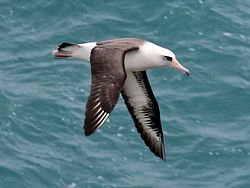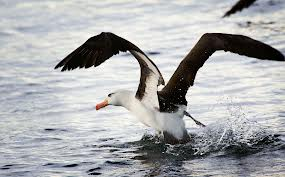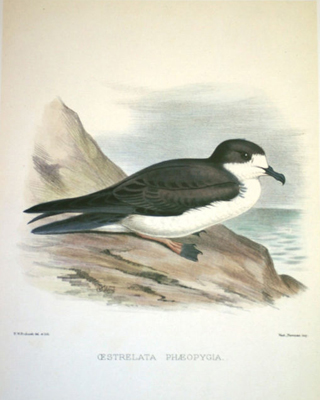*A Laysan albatross known as “Wisdom” – believed to be at
least 62 years old – has hatched a chick on Midway Atoll National Wildlife
Refuge for the sixth consecutive year.

During the morning hours on Sunday, the chick was observed pipping its way
into the world by U.S. Fish and Wildlife Service biologist Pete Leary, who
said the chick appears healthy. Wisdom was first banded in 1956, when she
was incubating an egg in the same area of the refuge. She was at least five
years old at the time.
“Everyone continues to be inspired by Wisdom as a symbol of hope for her
species,” said Doug Staller, the Fish and Wildlife Service superintendent
for the Papahānaumokuākea Marine National Monument (Monument), which
includes Midway Atoll NWR.
Staff and volunteers stationed on Midway are responsible for monitoring the
health of the beautiful seabirds that arrive every year by the hundreds of
thousands to nest. Upon the seabirds’ arrival, field staff monitor them and
gather information for one of the longest and oldest continuous survey data
sets for tropical seabirds in the world.
Wisdom has worn out five bird bands since she was first banded by U.S.
Geological Survey scientist Chandler Robbins in 1956. Robbins estimated
Wisdom to be at least 5 years old at the time, since this is the earliest
age at which these birds breed. Typically, they breed at 8 or 9 years of
age after a very involved courtship lasting over several years so Wisdom
could be even older than 62.
Bruce Peterjohn, chief of the North American Bird Banding Program at the
USGS Patuxent Wildlife Research Center in Laurel, MD, said Wisdom has
likely raised at least 30 to 35 chicks during her breeding life, though the
number may well be higher because experienced parents tend to be better
parents than younger breeders. Albatross lay only one egg a year, but it
takes much of a year to incubate and raise the chick. After consecutive
years in which they have successfully raised and fledged a chick, the
parents may take the occasional next year off from parenting. Wisdom is
known to have nested in 2006 and then every year since 2008.
“As Wisdom rewrites the record books, she provides new insights into the
remarkable biology of seabirds,” Peterjohn said. “It is beyond words to
describe the amazing accomplishments of this wonderful bird and how she
demonstrates the value of bird banding to better understand the world
around us. If she were human, she would be eligible for Medicare in a
couple years yet she is still regularly raising young and annually
circumnavigating the Pacific Ocean. Simply incredible.”
Sue Schulmeister, manager of the Midway Atoll NWR, said, “Wisdom is one is
one of those incredible seabirds that has provided the world valuable
information about the longevity of these beautiful creatures and reinforces
the importance of breeding adults in the population. This information helps
us measure the health of our oceans that sustain albatross.”
Almost as amazing as being a parent at 62 is the number of miles this bird
has likely logged – about 50,000 miles a year as an adult – which means
that Wisdom has flown at least 2 to 3 million miles since she was first
banded. Or, to put it another way, that’s 4 to 6 trips from the Earth to
the Moon and back again with plenty of miles to spare.
*About Albatross*
Albatross are legendary birds for many reasons – in Samuel Coleridge’s
poem, “The Rime of the Ancient Mariner,” a sailor has to wear an albatross
around his neck as punishment for killing the bird. According to seafaring
legends, albatross are the souls of lost sailors and should not be killed.
However, as reported by James Cook, sailors regularly killed and ate
albatross.
Albatross are remarkable fliers who travel thousands of miles on wind
currents without ever flapping their wings. They do this by angling their
6-foot wings to adjust for wind currents and varying air speeds above the
water.

Nineteen of 21 species of albatross are threatened with extinction,
according to the International Union for the Conservation of Nature.
Present threats to the birds include lead poisoning of chicks on Midway
from lead paint used in previous decades; longline fishing, where the birds
are inadvertently hooked and drowned, though conservation groups have
banded with fishermen and dramatically lowered the number of deaths from
this cause; and pollution, especially from garbage floating on the ocean.
The birds ingest large amounts of marine debris – by some estimates 5 tons
of plastic are unknowingly fed to albatross chicks each year by their
parents. Although the plastic may not kill the chicks directly, it reduces
their food intake, which leads to dehydration and most likely lessens their
chance of survival. In addition, albatross are threatened by invasive
species such as rats and wild cats, which prey on chicks, nesting adults
and eggs. Albatross evolved on islands where land mammals were absent, so
have no defenses against them.



